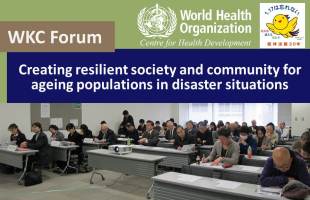WKC Forum report: Creating resilient society and community for ageing populations in disaster situations

In commemoration of the 20th anniversary of the Great Hanshin-Awaji Earthquake, the WHO Kobe Centre, in collaboration with the University of Hyogo, organized an open public forum on “Creating resilient society and community for ageing populations in disaster situations” in Kobe on 20 February 2015 and 43 audiences participated in the event.
In the Forum, five experts presented their knowledge, research outcomes, and suggestions from various perspectives including nursing and disaster management, social welfare for older populations, psychology, and community healthcare to explore major components of resilient society/community with ageing population. The presentations were based on the experts’ experiences and interaction with older populations.

Japan has the largest proportion of older adults in the world. As a result, aged populations were much more affected, and accounted for more than half the victims in the 1995 Great Hanshin-Awaji Earthquake and in the 2011 Great East Japan Earthquake. Survivors must cope with physical, psychological and social issues, e.g. linkage with neighbours is interrupted leading to more social isolation, continuity of medical care and access to healthcare systems can often be unavailable. Once the essence of a “community” is lost, it takes a amount of tremendous time to achieve their reconstruction. It was also suggested that we can effectively restore communities if people prepare countermeasures against natural disasters in times preceding a disaster. Resilience in a community can be developed through enhancement of residents’ mobility and support system for cooperation – something that can be limited in ageing societies that increases their vulnerability.
In the Forum, five experts presented their experiences: Dr Mitani, Associate Professor of Kyoto University, reviewed the epidemiology of health conditions affecting older persons after the Great East Japan Earthquake, that included identification of health risks experienced by older populations in temporary housing. This is important to prevent secondary deaths that are relevant to and happen after the initial disaster. Dr Kako, Consultant of the WHO Kobe Centre, presented a framework for disaster prevention relevant to global population ageing, focusing on restoration and rehabilitation after disasters. Dr Okamoto, Head of Protection Section, Tarumi Ward Office in Kobe City, reported lessons learned after the Great Hanshin-Awaji Earthquake and emphasized the need to support vulnerable communities and older people's health at all times –this was best way forward to supporting older persons during a disaster. Professor Yamamoto, Director of WHO Collaborating Center for Nursing in Disasters and Health Emergency Management, University of Hyogo, described efforts and research to support older people's health after an earthquake through the activity of the “Public health room in communities” and brought up the importance of social support as well. Dr Ochi, Director of Soma Central Hospital, pointed out the health impact of radiation and long-term evacuation at temporary houses based on her observations in Fukushima Prefecture after the Great East Japan Earthquake.
The speakers identified a few key recommendations emerging from their research and observations from the Great Hanshin-Awaji Earthquake in 1995:
- The significant need to address psycho-social issues such as social isolation and increasing older persons’ ability to monitor their health after a disaster.
- During the last 20 years, there has been an increased attention to the roles of respective organizations/authorities in emergencies to the needs of older persons that have helped planning for future disaster situations.
- Interaction and information exchange among organizations are indispensable on a daily basis for effective rescue and comprehensive support after natural disasters.
- The concept of disaster prevention needs to be included in everyday life. There is a great opportunity for older persons to be more involved in planning and activities for disaster prevention in ageing societies.

Programme & Speakers
Presentations (Japanese)
- "Older people’s health after the Great East Japan Earthquake: from the epidemiological perspective"
Dr Satoko Mitani, Associate Professor, Unit for Liveable Cities
Graduate School of Medicine, Kyoto University
- "Ageing society and disaster: report from global perspective"
Dr Mayumi Kako, Consultant
WHO Kobe Centre
- "Older people's health after the Hanshin Awaji Earthquake: learning from community support activities"
Dr Kazuhisa Okamoto, Head of Protection Section, Health/Welfare Dept.
Tarumi Ward Office, City of Kobe
- "Supporting people’s health through the activity of ‘Machi no Hokenshitsu (Public health room in communities)’"
Professor Aiko Yamamoto, Director, WHO Collaborating Center for Nursing in Disasters and Health Emergency Management
University of Hyogo
- "Health issues among the elderly after the Great East Japan Earthquake: a case in Fukushima"
Dr Sae Ochi, Director of Internal Medicine, Soma Central Hospital
Research Fellow, Imperial College London

